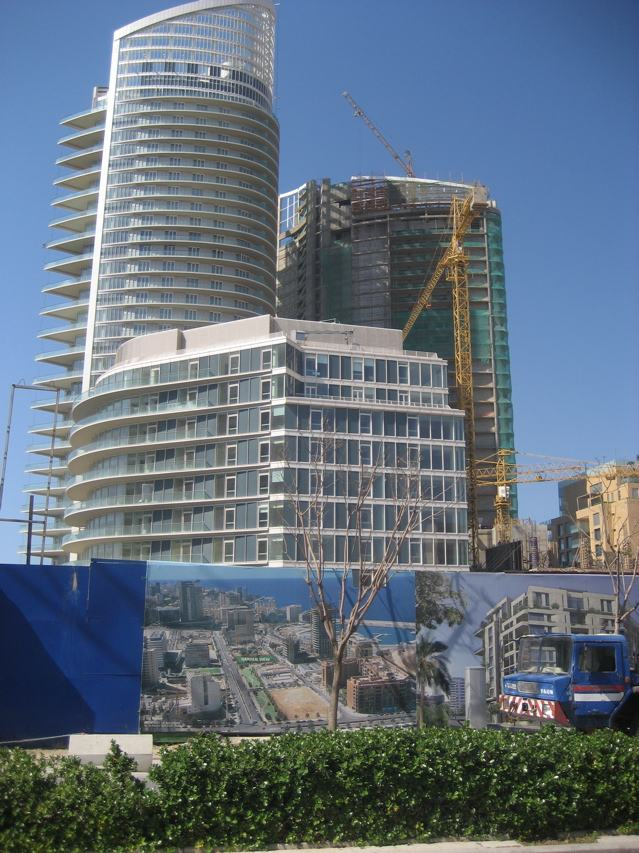 A country going through crazy times, it should have come as no surprise that Lebanon’s real estate prices doubled. "It’s completely ridiculous and against all forecasts of a difficult political situation. No one wants to sell at normal rates, everyone has now doubled their price," said Patrick Geammal, chairman and managing director of ASCOT. Whether real or imagined, such predictions have made their mark on sellers’ expectations and deals have stalled.
A country going through crazy times, it should have come as no surprise that Lebanon’s real estate prices doubled. "It’s completely ridiculous and against all forecasts of a difficult political situation. No one wants to sell at normal rates, everyone has now doubled their price," said Patrick Geammal, chairman and managing director of ASCOT. Whether real or imagined, such predictions have made their mark on sellers’ expectations and deals have stalled.
"If before the price of land was $2,000, they now want $4,000, but if you are willing to pay $4,000, they want $8,000," Geammal laughed.
Guillaume Boudisseau of Ramco Real Estate Advisors said he faced the same problem but believed that sellers cannot dictate prices. "They just don’t understand that they can’t set their own price," he said, adding that, "it’s mathematically based on the value of surrounding land."
Land scarcity is also a factor in pricing. In prime locations such as Ashrafieh, Hamra, Verdun, and Ramlet al-Baida, plots of land could be found two years ago. Today, however, there are only a few remaining plots, which is putting pressure on prices. "So those that held on to their lands are now asking ridiculous prices and making the market grow," said Geammal.
Prices have increased by 20% since March, prior to the clairvoyant’s prediction. "Growth is everywhere," said Nabil Gebrael, chairman of Caldwell Banker. He further stated prices only plateau during tough times for the market and resume to a steady increase once the market returns to normal. This phenomenon is due to two important factors: First, Beirut as a capital city is still inexpensive per square-meter compared to neighboring capitals such as Damascus and Amman. Second, building materials — steel, concrete, tiles, and fixtures — have increased due to the declining dollar against the euro. "In Lebanon, real estate is determined by cost, not market demand," insisted Gebrael. Bank Audi reported that the Construction Cost Index from end-2006 to end-June 2007 increased by 9.4%.
Beirut Central District
This year has been difficult for the Beirut Central District (BCD) because of the tent-city erected in December 2006. The BCD was an open area prior to the opposition’s protest, but since that time, added security measures and inconveniences, not to mention the desertion of patrons especially along the Riad el-Solh area, have left many restaurant, retail, and office renters looking for other areas. As the BCD awaits for an end to the protest, demand and rent prices remain stagnant. "The charm isn’t going to go away, it will come back," insisted Gebrael.
The near evacuation of businesses and restaurants from BCD has spawned new trends in other areas. For office space, issues such as access, traffic congestion, parking and space are taken into consideration. Offices have been gravitating toward areas with greater access to main roads, particularly suburban areas just outside city limits. Office areas in demand are along large thoroughfares such as Adlieh and the National Museum, according to Gebrael. Other popular areas are along Charles Malek Avenue, running from the BCD into Ashrafieh, as well as north of Beirut around the Antelias area. In West Beirut, office complexes such as Starco and Gefinor continue to maintain high occupancy rates. Yet no new proposals are being made for new office complexes.
Another trend sparked by the evacuation of the BCD is the new demand for Hamra. Restaurant chains that before shunned Hamra have now opened branches and demand continues to rise. "Every month we have a new demand for Hamra and we cannot find a new location to rent," said Boudisseau. While Hamra is becoming the de facto downtown, many current tenants in the area are old rents demanding large compensation for their spaces. "This could tack on another $500,000 or so to the cost of the property," added Boudisseau. The area is also continuing to change in character as more pubs are expected to open to accommodate college students.
Retail trends
For retail, two major trends have emerged. First, instability has pushed many shoppers to seek closed, secure environments such as ABC, City Mall, and BHV, making them prime locations for retail. "Security has made the prices per square meter explode," according to Geammal. Rent in ABC now runs between $2,000-3,000 per square-meter, which is high compared to property surrounding the shopping center, which can be bought for around $3,000-5,000 per square-meter. "They are renting at almost the same price they could buy a shop," said Geammal. The trend is expected to continue with malls and franchises set to open. However, Geammal maintained that these projects are proposed by foreign investors who find other countries more attractive at the moment. Carrefour, for example, was rumored to open a branch in Dbayeh but has now stalled the plan until there is stability.
The second trend is the emergence of Hamra and Kaslik as traditional retail areas. From 1990 until 2000, outlets were in demand in Kaslik as a retail center for the north. Since that time, Kaslik declined until recently, according to Boudisseau. Hamra also has witness an upsurge in popularity for retail.
In the BCD, retail shops have continued operations, but locate themselves along the seafront near the Marina Tower and Foch Avenue. High-end retailers such as Christian LaCroix and Valentino have opened recently, despite the trend to leave downtown.
Gemmayze’s appeal
Gemmayze’s charm and character continue to make it the local pub neighborhood. Four years ago, Gemmayze hosted only two pubs and a handful of restaurants. Since then, there has been more interest in the area, as 50-60 pubs and restaurants opened in the neighborhood. The high demand has continued this year and has yet to peak, according to Gebrael. While parking remains an issue at present, Gebrael is confident the market will work itself out, as new buildings are required to provide adequate parking and decrease the reliance on street parking.
Geammal cites two reasons for the continued growth. First, Gemmayze is seen as an extension of the BCD, which is within walking distance. It is also flat, allowing for pub-goers to move around with ease. Gemmayze continues to be the main neighborhood for pub-goers, taking away popularity from Monot. Boudisseau expects Monot’s character to continue to change as boutiques and small shops move in while the southern part of Monot, along Abdel-Wahab, remains an area for high-end restaurants.
Residential properties
Most residential properties are currently purchased by expatriate Lebanese, all of whom buy large apartments in prime locations in Ashrafieh, Ras Beirut, Verdun, and Ramlet al-Baida. According to Gebrael, non-Lebanese buyers make up less than 3% of the buyers on the market, while the purchases of this small number total around 17% of the total value of transactions. However, expatriate Lebanese take a larger piece of the pie. Local Lebanese and expatriates who recently moved to the Gulf are buying in the periphery areas such as Geitawi or around the Rizk Hospital in East Beirut. In West Beirut, they are buying in Zarif and Mar Elias. These areas will continue to be lower in price because of the compactness of the buildings, but the prices are steadily increasing, argued Gebrael. Rabieh and other places outside of city limits continue to be secondary in choice. Demand has not picked up in these areas. Geammal explained this is because everyone is focused on living within the city limits in Beirut. "They won’t accept to buy elsewhere," he said.
Looking toward 2008
Expectations for 2008 are based on whether there is a solution to the current political impasse and stability returns. If so, the market will need another two or three years before foreign investors return and the stalled developments could begin to break ground. If not, Gebrael maintained that prices will plateau until the situation gets better. "No matter what, prices will not decrease," said Gebrael.
© Executive 2007



